Dogs naturally shed their hair, and it is a common trait among most breeds. While the shedding process in dogs is similar to humans, it can have certain effects. In this article, we will explore the causes, treatment, and prevention of hair loss in dogs, allowing you to address this health condition promptly.
1 Is Hair Loss in Dogs a Physiological Characteristic?
Hair loss in dogs can be considered a normal physiological phenomenon, as it is a part of their development and does not affect their overall health. Dogs typically shed their hair twice a year, with some shedding more near the “heat” season. Depending on the climate, dogs may shed less hair in the summer to cool down or change their coat to keep warm in the winter.
However, if a dog sheds excessive hair in patches or experiences hair loss accompanied by abnormal symptoms such as itching, rash, and peeling skin, it is no longer simply a physiological characteristic. It may be a sign of a hair loss disease in dogs, and further investigation and timely measures should be taken.
2 Causes of Hair Loss in Dogs
Allergies
Allergies are a common cause of hair loss in dogs. Dogs are active and playful, often venturing into dense bushes or unclean places. This makes them susceptible to parasitic insects like fleas and ticks, as well as allergens like pollen and mold, which can cause diseases. Additionally, allergies to food or inappropriate shampoos can also lead to hair loss in dogs. Typical symptoms of allergies in dogs include itching, excessive scratching, biting, and hair loss in patches.
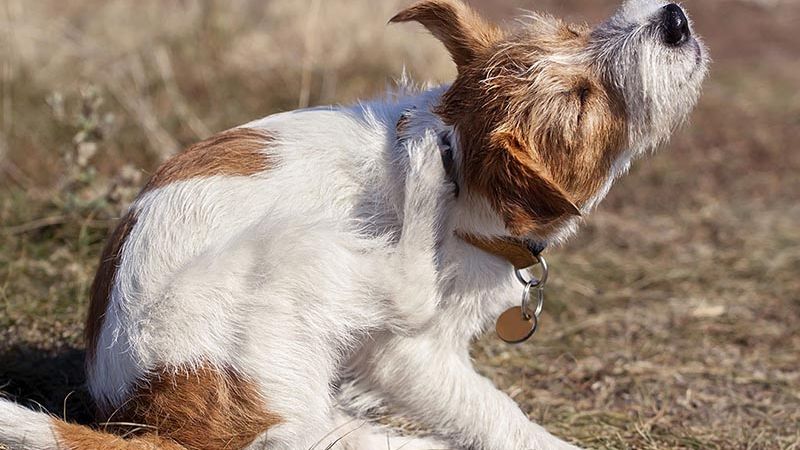
Hair loss in dogs due to allergies
Parasitic Infestation or Bacterial Infection
Fungi, bacteria, or parasites can cause dogs to experience hair loss in patches, especially in areas such as the chest, abdomen, and around the ears and eyes. This is often accompanied by itchy and swollen skin due to repeated scratching, biting, and licking of the affected areas. In some cases, conditions like whipworm can cause hair loss in round or uneven shapes, as well as inflamed and infected skin.

Infected with parasites or bacterial infections
Nutritional Deficiency
Diet plays a significant role in a dog’s health. Insufficient nutrients can lead to hair loss and dry skin. It is important to adjust the dog’s daily meals to ensure an adequate supply of necessary nutrients, promoting strong development, preventing skin diseases, and maintaining a shiny coat.

Hair loss in dogs due to nutritional deficiency
Cushing’s Disease
Cushing’s disease, also known as endocrine disorders, occurs when the body produces an excess of cortisol hormone compared to normal levels. This can be caused by natural imbalances or prolonged use of high-dose corticosteroid medications. Symptoms of Cushing’s disease in dogs include hair loss, darkened skin, swollen abdomen, excessive thirst, increased appetite, and fatigue. This condition typically affects middle-aged to older dogs.
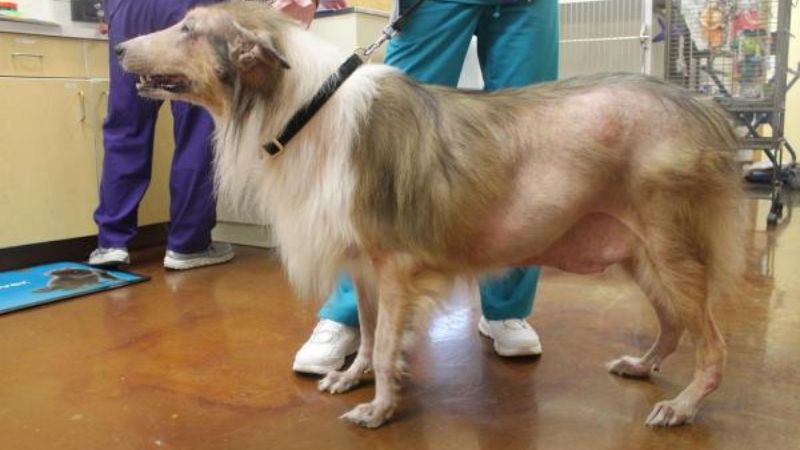
Hair loss in dogs due to Cushing’s disease
Genetic Factors
Mating can unintentionally result in excessive hair loss in dogs due to the inheritance of unwanted characteristics or genetic diseases. Some breeds, such as Mexican hairless (Xolo), Dachshund, Chihuahua, and Whippet, are known to shed a lot of hair due to genetic factors.

Hair loss in dogs due to genetics
3 What to Do When You Discover Hair Loss in Dogs?
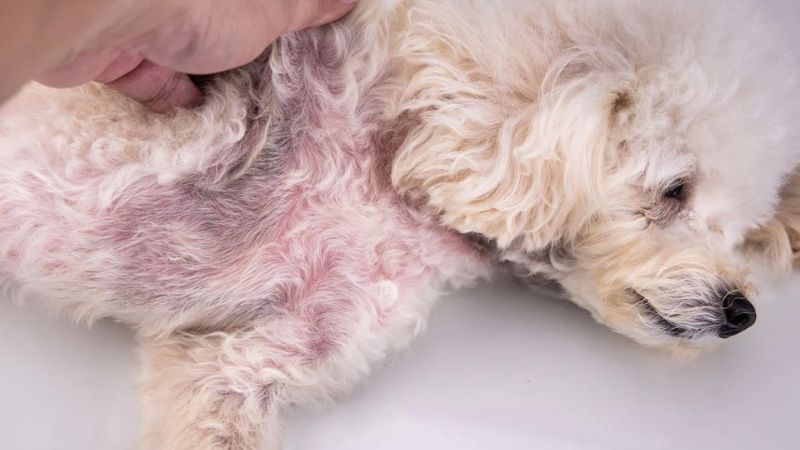
What to do when you discover hair loss in dogs?
4 Treatment and Care for Dogs with Hair Loss
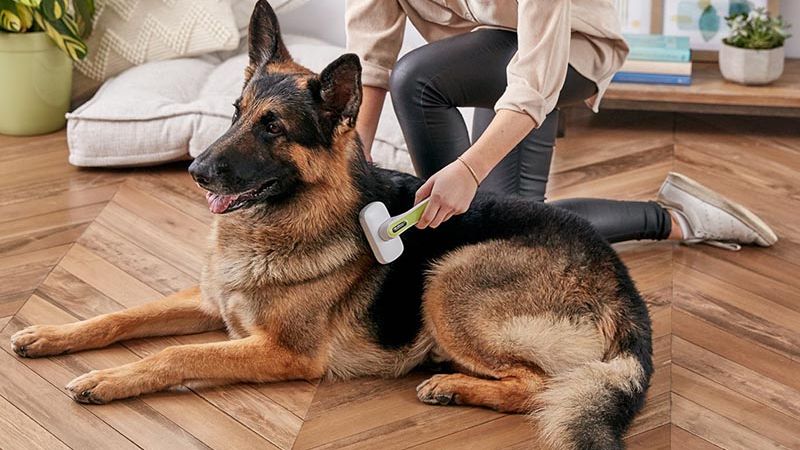
Treatment and care for dogs with hair loss
Note: For effective treatment, it is recommended to take your dog to a veterinary clinic and consult with experts and veterinarians for advice.
Establish a Nutritious Regimen: Ensure the dog’s diet includes a balanced amount of nutrients, including proteins, vegetables, fruits, legumes, and healthy fats like olive oil. Provide an adequate supply of water and avoid excessively spicy foods.
Use Medications: Medications are available in various forms, such as injections, ointments, or oral medications. Consult with a veterinarian for advice and support in the treatment process. Some medications may stimulate hair growth.
Regular Brushing: Regularly brushing the dog’s coat helps remove old shedding hair, detangle the fur, and eliminate some dirt. It is also beneficial to use grooming products designed specifically for dogs to stimulate the growth of new, healthy hair and promote shine. Use a dedicated dog grooming comb and brush gently to help the dog relax.
Maintain Clean and Ventilated Environment: In hot and humid climates, harmful agents tend to develop. During the shedding season, use a vacuum cleaner to clean indoor environments and ensure the dog’s living space is clean and well-ventilated to prevent odors, bacteria, and mold. Clean the dog’s kennel and bedding at least once a week.
5 Preventing Hair Loss in Dogs
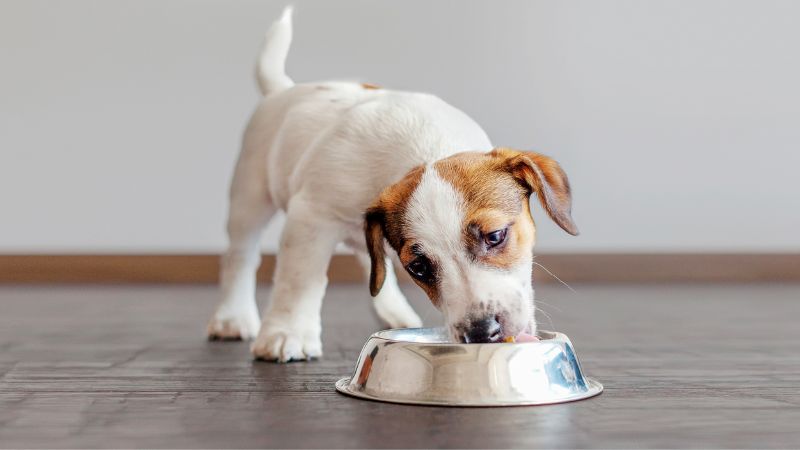
Preventing hair loss in dogs
Regularly check the dog’s health and vaccinate them according to the recommended schedule to prevent skin diseases. Follow the veterinarian’s instructions for vaccinations.
Ensure the dog’s daily meals contain sufficient nutrients and vary their diet to prevent boredom. Avoid feeding the dog excessively salty food.
Maintain cleanliness and hygiene for the dog using specialized dog products, avoiding the use of human products.
Provide regular exercise and activities for the dog to improve their health and enhance their immunity. Keep the dog’s living environment clean and well-maintained, ensuring cleanliness and proper ventilation.
Regularly brush the dog’s coat at least once a day, using gentle strokes to help them relax and feel your love.
6 Frequently Asked Questions About Hair Loss in Dogs
How often do dogs shed their hair?
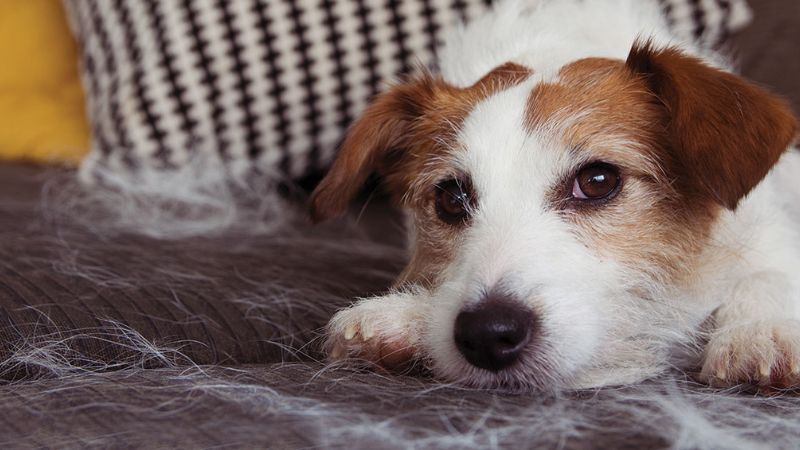
How often do dogs shed hair?
Most breeds shed their hair seasonally, typically twice a year. Female dogs may experience a coat change before their heat season. Male dogs can shed hair throughout the year, but in smaller amounts. Some breeds, like the Husky or German Shepherd, shed hair all year round, while others, like the Poodle or short-haired Chihuahua, shed less frequently.
Is it recommended to use anti-shedding shampoo for dogs?

Should I use anti-shedding shampoo for dogs?
Veterinary experts state that one of the main causes of hair loss in dogs is unclean hygiene. Bathing your dog helps minimize dead cells and reduce the amount of hair and dirt floating around the house or sticking to carpets, clothes, and food. Therefore, using a suitable shampoo designed for dogs is recommended to ensure their overall health.
Through the information shared in this article, we hope you have gained useful insights into treating and preventing hair loss in dogs. Wishing you and your furry friends good health!

































